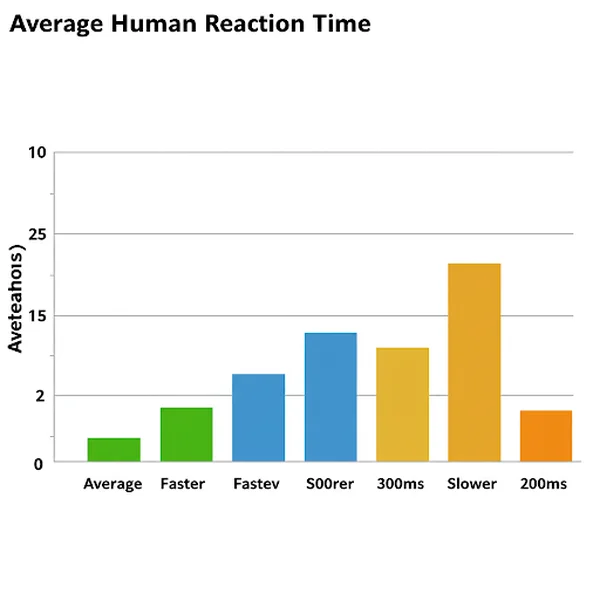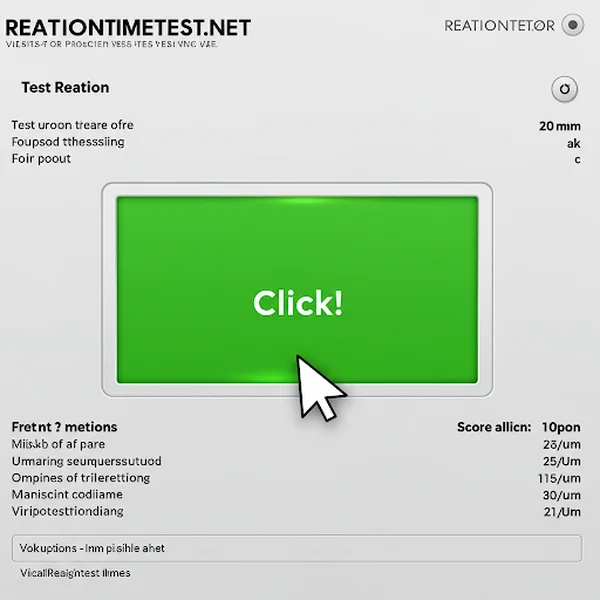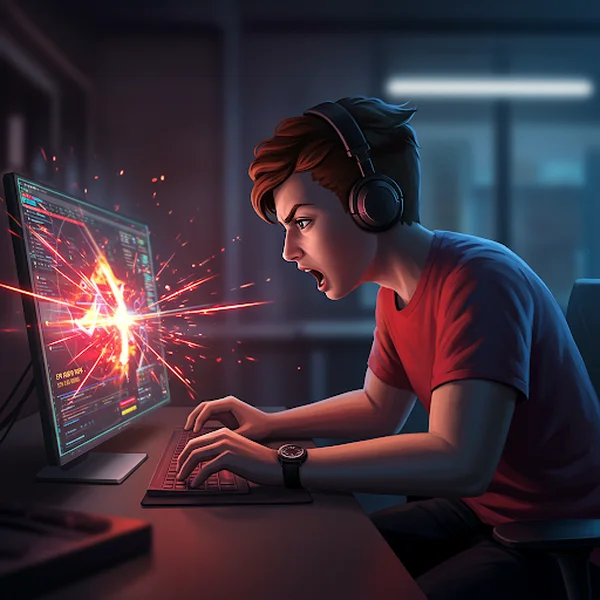Average Human Reaction Time: Understanding Scores
So, you've just completed a reaction time test, maybe even our own visual test here at reactiontimetest.net, and now you have a score – likely measured in milliseconds (ms). The big question popping into your mind is probably: What is the average human reaction time? And more importantly, how does your score stack up? Understanding where you fall on the spectrum can be both insightful and motivating. This article dives into the benchmarks for human reaction time, helping you interpret your score effectively. Ready to see how you compare? You can always test your reaction time again as you read along!

Defining Average Reaction Time: More Than Just a Number
Before diving into the numbers, let's clarify what we mean by reaction time and its average.
Reaction Time Explained: Stimulus to Response
In simple terms, reaction time is the duration it takes for your body to respond to a specific stimulus. For visual reaction time, like the test on our site, it's the time between seeing a change (like the color turning green) and executing a physical response (like clicking the mouse). This involves your eyes detecting the stimulus, signals traveling along your neural pathway to your brain, your brain processing the information and deciding to act, and finally, signals traveling to your muscles to perform the action.
Why "Average" Varies: Understanding Statistical Norms
The term "average" refers to a typical value within a group. However, human reaction time isn't a single fixed number. It varies significantly from person to person and even for the same person at different times. The average reaction time we discuss is usually a statistical mean or median derived from large population samples, giving us a general reaction time benchmark.
Focusing on Visual Reaction Time
There are different types of reaction times (auditory, tactile), but the most commonly discussed and tested, especially online, is visual reaction time. This is what our test measures and what most general benchmarks refer to unless specified otherwise. Knowing this helps compare apples to apples when looking at average scores.
The Science Behind Reaction Time: How Fast Can Humans React?
Understanding the biological basis gives context to the numbers. How fast is human reaction time fundamentally limited?
The Neural Pathway of Reaction
As mentioned, reacting involves a complex chain: sensory input -> nerve transmission -> brain processing -> motor command -> muscle execution. Each step takes time, measured in milliseconds. Delays in any part of this chain can affect the overall reaction time.
Factors Setting Biological Limits
Pure human reaction time has physiological limits. It's generally accepted that reaction times much faster than 100ms are physically improbable for humans responding to a visual stimulus, as the neural processing itself takes time. Scores significantly below this might indicate anticipation rather than true reaction.
Simple vs. Choice Reaction Time Basics
Our test measures simple reaction time – one predictable stimulus and one response. Choice reaction time involves multiple stimuli and/or responses, which naturally takes longer due to the added decision-making process. Most online benchmarks refer to simple visual reaction time.
Average Reaction Time Benchmarks: Where Do You Stand?
Okay, let's get to the numbers. Where does the typical person fall? Keep in mind these are general figures based on various studies.
General Average Human Reaction Time (Visual Stimuli Range)
For simple visual stimuli, the most commonly cited average human reaction time falls between 200ms and 300ms. Many sources place the average closer to 250ms. If your score is within this range, you're generally considered quite typical.

Reaction Time Benchmarks by Age Group (Trends)
Reaction time age correlation is well-documented. Reaction times tend to be fastest in young adulthood (peaking in the early to mid-20s) and gradually slow down with age. Teenagers often have quick reactions, potentially faster than the general average. Older adults might see scores increase beyond the 300ms mark. What is the average reaction time for a teenager? While varying, it often falls comfortably within or even slightly below the 200-250ms range.
Typical Reaction Time: What's Considered Normal?
So, what is considered normal reaction time? Anything within that broad 200-300ms range is generally seen as normal or typical for an adult. Scores below 200ms are considered quite fast, while scores consistently above 300-350ms might be slower than average. However, "normal" is a wide band!
Understanding Your Score in Milliseconds (ms)
Remember, these scores are in milliseconds (thousandths of a second). A difference of 20ms might seem small, but in activities requiring quick reflexes (like gaming or sports), it can be significant. Familiarize yourself with interpreting your reaction time ms score through a reliable milliseconds test.
Factors Influencing Your Reaction Time Score
Why might your score differ from the average, or even vary from test to test? What affects reaction time? Several factors play a role:

The Role of Age and Biological Changes
As mentioned, age is a primary factor. Natural biological changes affect nerve conduction speed and processing efficiency over time.
How Alertness and Fatigue Impact Speed
Being tired, drowsy, or even just less alert significantly slows reaction time. Testing when you are well-rested and focused usually yields better results. This is one of the biggest day-to-day factors affecting reaction time.
Concentration Levels and Distractions
If you're distracted or not fully concentrating on the test, your brain takes longer to register and respond to the stimulus. Minimizing distractions is key for an accurate reaction time score.
Technical Factors: Monitor Refresh Rate and Input Lag
While often minor, factors like your monitor's refresh rate and mouse input lag can technically add a few milliseconds to your score. However, for most users, biological factors are far more significant.
Interpreting Your Score from ReactionTimeTest.net
Now, let's bring it back to the test you might have just taken on our site. How do I interpret my reaction time score here?
How Our Red-to-Green Test Works
Our test provides a simple visual stimulus – the color changing from red to green. You react by clicking. This directly measures your simple visual reaction time. It's designed to be a straightforward human benchmark tool.

Using Your Score as a Personal Benchmark
While comparing to averages is useful, the best use of your score is as a personal reaction time benchmark. Test yourself regularly under similar conditions (e.g., same time of day, similar alertness level) to track your own performance and see if you improve over time.
Comparing Your Results to General Averages
Use the benchmarks discussed (200-300ms average) as a general guide. Don't fixate on being slightly above or below average. Consistency and personal progress are often more meaningful. See how you measure up with our online benchmark test online.
Making Sense of Your Average Reaction Time
Understanding the average reaction time provides valuable context for your own scores. Remember that it's a range, influenced by many factors from age to how much sleep you got last night. Use your reaction time score not as a final judgment, but as a data point to understand your current capabilities and potentially track improvement.
What's your typical reaction time? Share your experience or questions in the comments below! Ready to check reaction time again or try to beat your previous score?
Your Questions About Average Reaction Time Answered
Here are answers to some common questions:
What is considered a good reaction time in ms?
Generally, scores consistently under 200-215ms are considered very good or fast reaction time. However, "good" can be relative to the activity (e.g., elite gamers aim lower). Anything within the typical 200-300ms range is perfectly fine for most people.
What is the average reaction time for a teenager (e.g., 13-year-old)?
Teenagers often have some of the fastest reaction times, frequently averaging between 200ms and 250ms, potentially even slightly faster, though individual results vary widely.
Can I improve my reaction time if it's below average?
Yes! While is reaction time genetic? partly plays a role, reaction time is a trainable skill for most people. Practice, specific drills, and lifestyle adjustments (like better sleep) can lead to improvements. You can start by regularly using our reaction speed test to track progress.
Is my reaction time score good or bad?
Instead of "good" or "bad," think "typical," "faster than average," or "slower than average." Compare your score to the benchmarks (200-300ms average) and, more importantly, to your own previous scores to gauge personal performance.